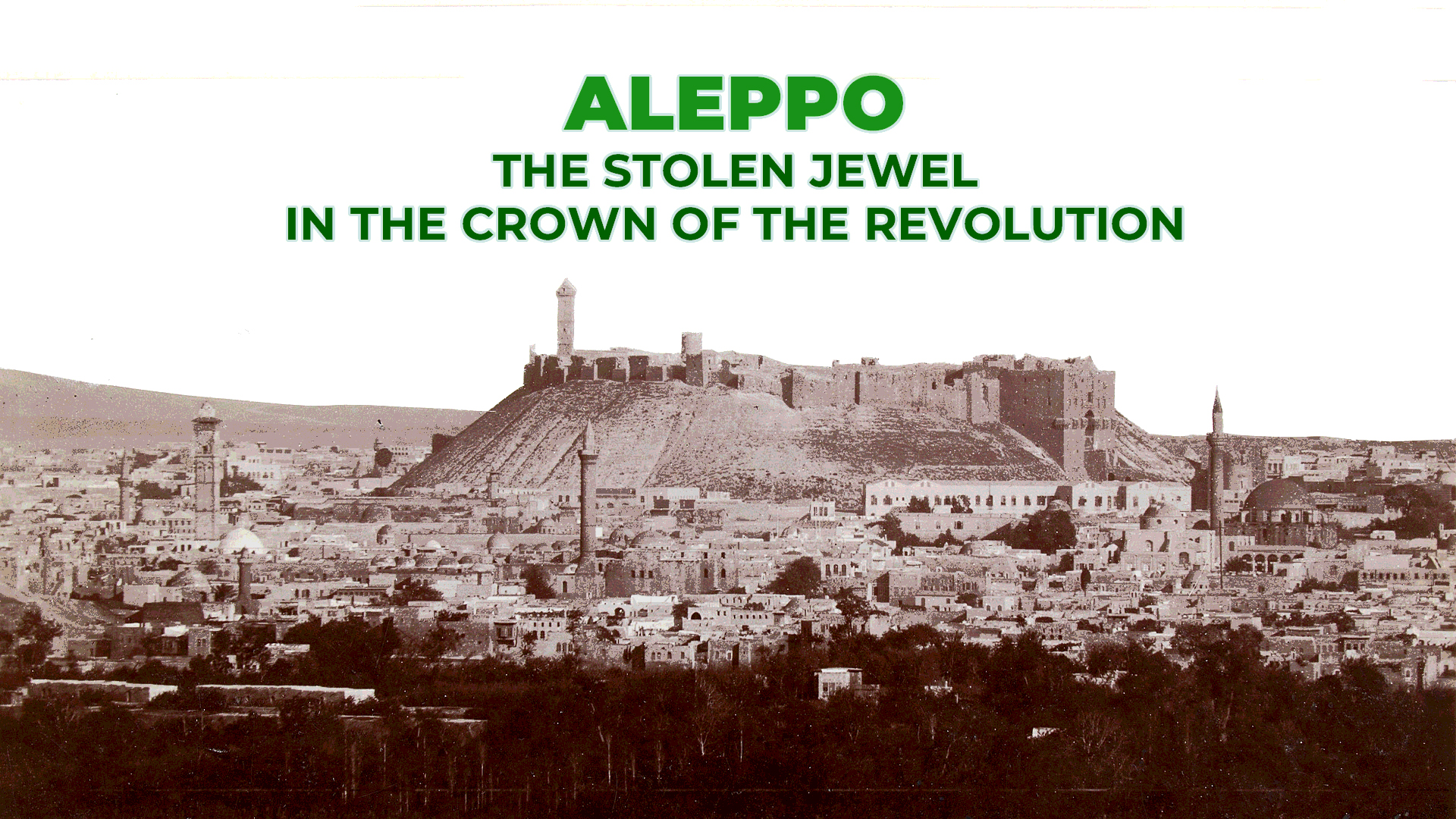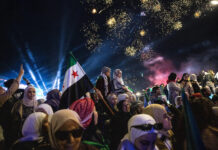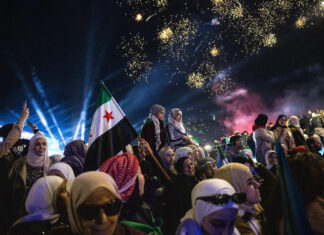
Aleppo City, with its rich history and economic significance, has played a pivotal role in the Syrian revolution. The city’s liberation marked a significant advancement for the uprising, but its subsequent fall brought about immense devastation and hardship. It has been seven years since the brutal battle for Aleppo, the role of external parties, and the occupation by foreign forces have left the city in ruins. However, amidst the despair, the will and desire of the people and the revolution to return to Aleppo and liberate it remains unwavering.
A Jewel of History and Economic Significance
Aleppo, a city with a history dating back over 12,000 years, stands as a testament to the enduring legacy of ancient civilizations and the economic prowess of the Levant. Dr. Ibrahim Shashu, an esteemed scholar from Damascus who now teaches at Idlib University, emphasized that Aleppo has long been considered the economic capital of the region. Its strategic position as a major hub on the Silk Road facilitated thriving commerce, industry, and tourism, making it a beacon of economic prosperity and a custodian of archaeological treasures.
Arif Sharifa, a lawyer who was forced to leave in 2016 following the brutal siege of the city, echoed the sentiments of Aleppo’s historical and economic significance. He emphasized the city’s rich heritage from ancient civilizations and its pivotal role as an economic capital, further reaffirming its historical and economic status.
Dr. Shashu underscored Aleppo’s pivotal and historic role as an icon of the revolution, highlighting its status as the largest liberated city and a crucial center of the uprising. Its roots, said Shashu, reached back to the uprisings of the 80s, “Aleppo’s importance was prominent in both revolutions, first in the 1980s and then in the current uprising. In the 1980s, Aleppo, second only to Hama, suffered harm from the oppressive regime. In the current revolution, it was the first city that faced no competition regarding the harm inflicted by the regime.”
The city’s gradual liberation posits Shashu, marked a significant milestone for the revolution, symbolizing a beacon of hope and resistance. He emphasized Aleppo’s active participation in the revolution, with its diverse demographic composition representing a Sunni majority and various ethnic groups. This diversity, coupled with its economic importance, rendered Aleppo a key player in the Syrian revolution due to what Shashu said is, “Its history, reality, and geographical and economic significance.”
Given its value to regional economics, the centuries-long status as the Levant’s industrial and business capital, and the importance of the uprisings of the past and the recent 2011 revolution it became the main focus of not only the revolutionary factions but also the Assad regime.
A Tragic Chapter in the Revolution’s History
The city of Aleppo, once a bustling metropolis and a key center of the Syrian revolution, bore witness to one of the most devastating sieges in modern history. The accounts of those who experienced the siege and fall of Aleppo paint a harrowing picture of hardship, displacement, and despair.
Sharifa vividly described the profound shock and suffering that accompanied the city’s fall. He emphasized the material and psychological impact on civilians and revolutionaries, as they were forced to leave behind their homes and livelihoods. However, amidst this despair, he noted a spirit of resilience as people regrouped and sought to overcome the challenges they faced.

In an interview with L24, Abu Hamza al-Firdousi, another military figure in Aleppo during the siege, provided a firsthand account of the fierce battles and the tightening grip of the siege on the city. He detailed the besiegement of critical areas and the subsequent displacement of residents and fighters to the western countryside of Aleppo and Idlib. The fall of Aleppo led to widespread displacement, with many residents and fighters seeking refuge in neighboring regions or even leaving the country altogether. The psychological toll of the devastation and the unforgettable massacres that occurred in the city continue to haunt those who survived.
Yeghia Tashjian, an expert in geopolitical affairs, highlighted the significance of Aleppo’s capture for the Syrian regime. “From a geopolitical perspective,” says Tashjian, “the capture of Aleppo was important for the Syrian regime as the city was the second major center for the middle class in Syria and it was a key transit hub connecting key Syrian cities in the north. The victory over the rebels with the help of the Russian military intervention was also a symbolic victory for the regime and important to bring back its legitimacy by controlling one of the major cosmopolitan cities in the country.”
The siege and fall of Aleppo brought about untold suffering for its inhabitants. The city faced relentless attacks, a suffocating siege, and a policy of starvation, leading to the collapse of morale. The loss of Aleppo led to displacement, disheartenment among the fighters, and unforgettable massacres. The external influences of Russia and Turkey, with their military interventions and strategic maneuvers, significantly impacted the outcome of the battle.
Foreign Agendas
External parties, particularly Russia and Turkey, played decisive roles in the fate of Aleppo. Russia’s scorched-earth policy and airstrikes, coupled with Turkey’s diversionary tactics, further complicated the already dire situation in the city. The immense pressure exerted by Russia, including inhumane sieges and military intervention, led to forced displacement and added to the suffering of Aleppo’s residents.
During the long war for the city, al-Firdousi highlighted the significant impact of Russian intervention in the conflict. He said the Russian forces employed a scorched-earth policy, intensifying airstrikes and targeting vital centers, including hospitals and medical points. This ruthless approach left no secure place for treating the wounded, exacerbating the humanitarian crisis and leading to a collapse of both the civilians’ and fighters’ morale. The suffocating siege and policy of starvation imposed by Putin’s forces further compounded the suffering of Aleppo’s residents, ultimately forcing the revolutionaries to negotiate the city’s surrender and the evacuation of its inhabitants.
Yet the brutal siege and attacks of Russia, which seemed intent on leveling the liberated parts of the city, were not the sole outside influence cited for the city’s fall. Dr. Shashu discussed Turkey’s involvement in the city’s fate. He noted, “In Aleppo, Turkey hasn’t explicitly stood against the revolution, as some may think. However, it withdrew its hand from Aleppo, being a state with its calculations.” Dr. Shashu surmises Turkey was more concerned with pursuing its own goals, particularly in combating the PKK organization along its borders than with opposing Russia and Assad in Aleppo. He also pointed out that Turkey had enticed many revolutionaries with material incentives to serve its project rather than the revolution’s objectives.

What Tashjian calls “co-opetition” is the adversarial collaboration between Russia and Turkey which, according to a report by the German Institute for International and Security Affairs (SWP), began in Syria before expanding to places like Libya and Nagorno-Karabakh. Concerning Aleppo, the SWP asserts that in 2016, Russia gave the green light for the Turkish incursion into Syria, and in return, Ankara effectively facilitated the regime takeover of Aleppo, the most important city under rebel control.
This collaboration between Russia and Turkey significantly influenced the dynamics of the Syrian conflict and the fate of key strategic locations such as Aleppo. The two then pushed forward on their Astana project and the regional and international political profiles of the countries were bolstered on the global stage. In Syria, Turkey could focus on the northern border campaigns against the PKK while Russia achieved ascendancy over Iran and greater control and influence with Assad.
Al-Firdousi agrees Turkey played a role in dividing the attention and resources of the revolution by invoking them in “the side battles led by the Turks,” particularly in the Battle of Euphrates Shield against ISIS. This diversion of attention from the ongoing battles in Aleppo had a significant impact on the city’s conflict. Qutaibah al-Shami, a former military commander who fought in Aleppo, emphasized the influence of external parties on the city’s fall. Russia’s military intervention and air superiority, along with Turkey’s role in pressuring factions and discouraging unity, significantly impacted the conflict. The tragic fall of Aleppo, he affirms, was a culmination of these external influences, combined with internal challenges faced during the prolonged battle and siege.
Sharifa, who lived in the liberated half of the city in those days added, “immense pressure exerted by Russia, including its unjust siege of Aleppo, led to an agreement with Turkish officials for the forced displacement of its inhabitants.” However, there was a lack of clarity and transparency in Turkey’s positions, which had a negative impact on the civilian population and revolutionaries in Aleppo.
The result was the forced exodus of over 34,000 residents in a deal brokered by Russia. Journalist Zouhir al-Shimale wrote about the ordeal. He paints a harrowing picture of the evacuation describing the chaotic scenes wherein thousands of people waited for hours in freezing weather without adequate provisions.
The overcrowded buses, lack of blankets, and scarcity of food and water made the journey unbearable, particularly for the injured, disabled, women, children, and the elderly. He mentioned the fears and anxieties regarding safety, especially as they passed through devastated areas and encountered Assad regime soldiers and militias at checkpoints. Many were skeptical about promises of safety and expressed concerns about being displaced from their homes and the changing demographics of their areas. While they found some relief once they reached western Aleppo and Idlib their hearts were heavy realizing they were displaced with no way back to their beloved Aleppo.
The Will to Return and the Call for Liberation
Since the fateful December in 2016, when lines of green buses took the people who had endured six years of bombs and hardship away from their homes, the overwhelming desire to return and liberate the city remains unwavering, serving as a prelude to the liberation of the entire nation. Sharifa was one of thousands evacuated on those green buses, he is resolute that, “The liberation of Aleppo remains a top priority for the Syrian people and the Syrian revolution due to its economic, commercial, and industrial significance, (it is) is an overwhelming desire for everyone and serves as a prelude to liberating the rest of Syria.”

Regarding what he called the “material causes,” he emphasized the need for the Islamic resistance movements and the Muslim nation to exert their utmost effort and contribute what they can. Pointing out that Muslims have historically been outnumbered or outmatched in battles but have succeeded through their collective efforts. He cited examples from Afghanistan and Gaza, where victory was achieved through collective efforts rather than sheer numbers or technological or economic supremacy.
The road to the liberation of Aleppo and, by extension, the entirety of Syria, is paved with challenges, both ideological and material. The call for unity, sacrifice, and steadfastness echoes throughout the Syrian revolution, emphasizing the need for a collective effort to achieve the shared goal of liberation. The desire to return to Aleppo and the determination to see it liberated stand as a testament to the resilience and unwavering spirit of the Syrian people. As the struggle for freedom and justice continues, the call for unity and collective effort remains at the forefront of the revolutionary goal to reclaim and rebuild Aleppo, symbolizing the hope for a liberated and prosperous Syria.








